Synchronicity is a most meaningful thing, and as researchers everywhere would agree, guides the unravelling of themes. The following article by Dan Green is testament to the many links inherent in various things: cathedrals, comets, and tombs to name a few, which in the context of the ancient history of mankind, face us with curious clues…
Read on to find out more about the intriguing mystery of Rennes le Château, and what it could have to do with daggers, and comets.
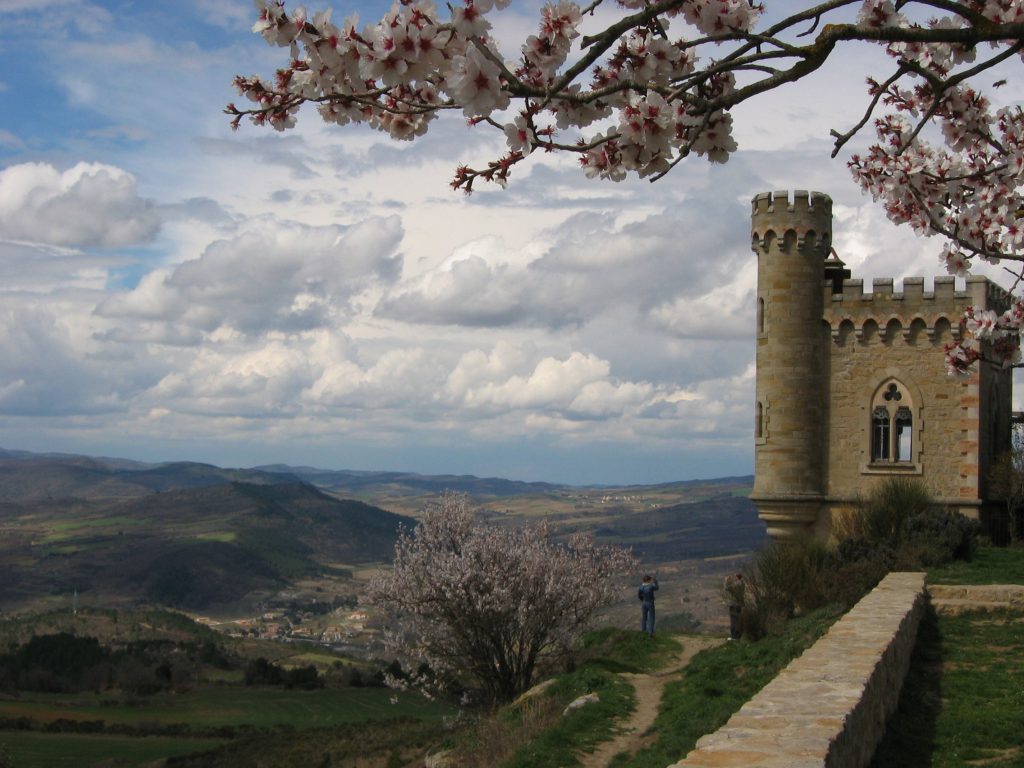
‘La Tour Magdela’ at Rennes Le Château: a small village perched on a hilltop near Couiza in the Aude department of Languedoc, France ©Chosovi CC BY-SA 2.5
The mystery of Rennes le Château, to some not even a mystery but a fraudulent hype, is one of those ‘Marmite’ situations – you either love or hate it. Either way, it has been hard to ignore since the late seventies and the 1982 publication of The Holy Blood and the Holy Grail. After the detective work carried out in the valley by the intrepid three co-authors of this controversial book, and with the exception of my friends, the prolific all-mysteries-considered authors Lionel and Patricia Fanthorpe, I think I may be justified in declaring that I, wife in tow also, was the very next British interest to immerse oneself in the Rennes affair, visiting there and involving myself directly, much to the chagrin of the locals and whoever else lurking in the authoritative shadows.
A little over thirty years later and there has been a lot to look back on, for each time I thought the mystery had clearly announced itself to my honest endeavours, the kaleidoscope would shake and the concluding picture, if there were one, would change yet again before my very eyes. It takes courage for an author to perceive and acknowledge this and be brave enough to evolve their deductions before any audience who’d much prefer it comfortably and unambiguously over and done with, in one solitary fashion. When you have put so much (holy) blood, sweat and years into seemingly never ending and time consuming research, the humble author is left feeling not quite the same.
The three decades had seen me entangle with, predictably, the quizzical figure of the biblical Mary Magdalene, for many the key figure in the Rennes-le-Château enigma; and unpredictably, the transposition of the Rennes mystery over to the gothic Cathedral of Lincoln, England and its immediate environments. For how was I to know that sacred geometry first discovered in the Rennes Valley would duplicate to such an extent in the Lincolnshire landscape to actually overlay it? (1) Initially, in 2005, the Cathedral allowed me a GPR scan at a definitive location I had announced adjacent to the southeastern corner of the edifice, but as the time grew nearer they reneged and went silent over the matter, thus causing an additional mystery in its own right (2). Why the U-turn? Five years later an unofficial scan conducted at the same spot by two naughty fearless adventurers from Europe showed a sarcophagus-shaped object along with a metal oblong. If there was a search for some holy relic associated with the Scarlet Saint, then treasure hunters best pack their bags if they aren’t already living in the UK. The Magdalene aspect of it all had many facets attached and one of them, which fascinated me the most, was that of a comet.
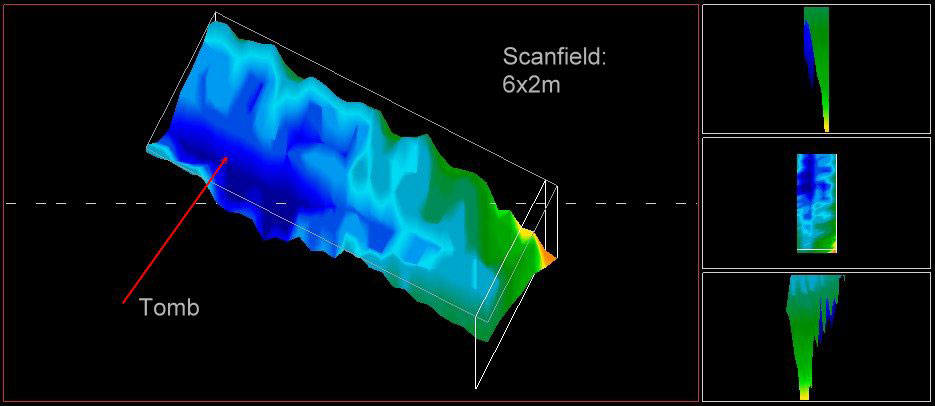
Result of the 2011 GPR scan of the site in Lincoln Cathedral. A sarcophagus-shaped object appeared in the scan, which was given to the author by an anonymous geophysicist. ©Green.
I am not the first to have detected this allusion, but I will claim to be the second, for in the light of Graham Hancock’s own work I find this not only interesting but potentially of a crucial importance. Let me explain. In 1985 I had an acquaintance with daring researcher David Wood of Tunbridge Wells in Kent, qualified in the fields of trigonometrical surveying and cartographical reproduction. David had an active interest in Rennes-le- Château (before he eventually was made unwelcome and ‘banned’ from the valley). Picking up the baton from Henry Lincoln, (great synchronicity occurring with the surname) David recognised ancient geometry concealed in the landscape, and shared this in his two Egyptian flavoured self-published books GenIsis, and Geneset – Target Earth co-written with Ian Campbell, the first of which was saturated in blatant sexual imagery.
His intervention, for his troubles, caused him precisely that: trouble. In 1989, four years after GenIsis, his home was raided at night when eleven cars pulled up outside and waltzed off with as much of his work they deemed necessary. David felt that he was being set up for tax evasion, something he wasn’t guilty of.
Many of the earlier problems he had encountered I will keep to myself. In 1994 the conclusion of his findings were presented in Geneset, and to most readers, they were both unexpected and surprising. Employing his geometry coupled with maths he cracked the famous (or infamous) ‘ET IN ARCADIA EGO’ code on the Poussin tomb, held by many to be the definitive clue to the mystery. Situated close to Rennes-le- Château, the tomb, which existed in the valley until 1988 when the angry owners of the visitor weary land blew it to pieces with dynamite, was a replica of that shown on Nicolas Poussin’s original 1638 canvas, ‘The Shepherds of Arcadia’.
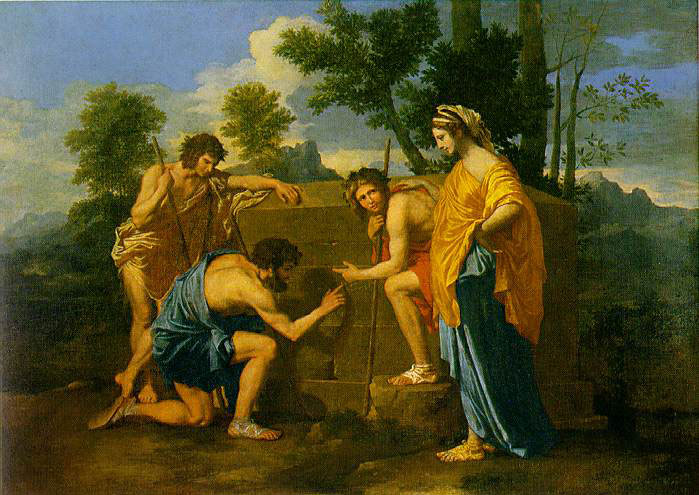
‘The Shepherds of Arcadia’ by Silaghi Alexadre, painted between 1638-1640 and currently held in the Louvre Museum, Paris.
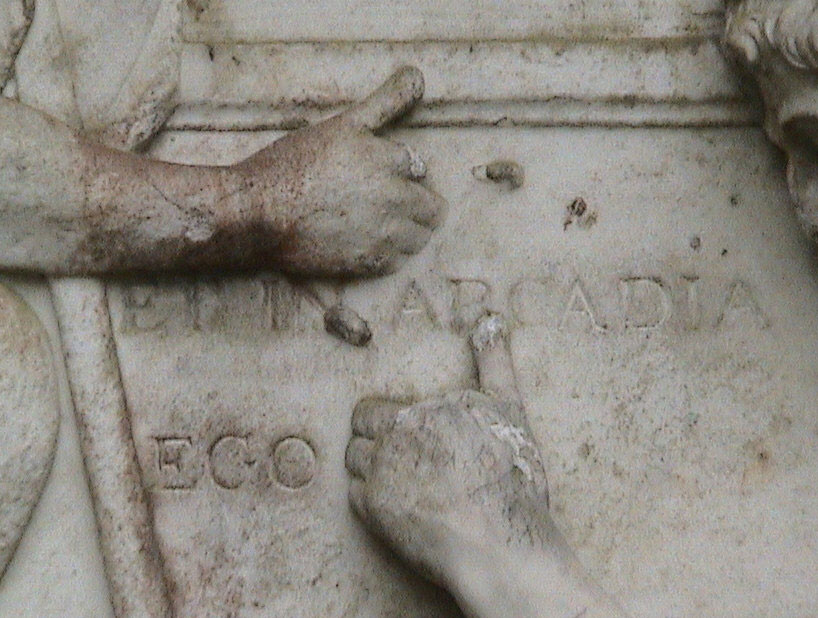
‘ET IN ARCADIA EGO’ code, on the ‘Poussin’ tomb. ©Edward Wood CC BY-SA 3.0
David deduced the hidden message within the Poussin tomb was that of ‘ICE GOD’, which referred to a comet heading this way, and due, he estimated, around 2085. (3) Rather like the revealing research of Hancock et al concerning Gobekli Tepe in Turkey, the astronomical message encoded in the Sphinx, and the Giza pyramids of Egypt, we have here, it appears, another tip off of a relatively imminent comet on course for impacting earth. In Graham’s case it has been dubbed the ‘Clovis Comet’ after the so-called ‘Clovis’ peoples and culture of North America, and its arrival estimated at no later than 2040.
Back in Lincoln, I was beginning to wonder the same thing. The dangling carrot of a century’s search for the ever metamorphosing meaning of the Holy Grail, a contrived paper chase designed so we never lose interest and stop searching, had kept presenting me with the appearance of a dagger. Most of my deductions, if not almost all, have arrived my way by the mechanism of the Collective Unconscious, and its accomplice, the wonder of synchronicity. I found that information allegedly guarded and slowly intimated at by secret societies such as the Freemasons less fruitful, although I have had it told to me more than once that I have rattled the cage of the latter. Jonathan Black, for example, in his The Secret History of the World informs us from such sources that what Poussin was pointing to in his ‘Shepherds’ painting, was the tomb of Mary Magdalene. (4)
In 1995, the then-Dean of Lincoln Cathedral publicly declared a battle of good and evil by wanting to close it for three months to have it exorcised, although this never transpired. (5) The cathedral, with its chequered and often dark history, has many anomalies – from the placing of its Rose Window and a dog on the platter at the scene of ‘The Last Supper’ on the Great East Window, to deliberately constructed sacred geometry and the 13th century demonic figure of the ‘Lincoln Imp’, whose right leg is crossed in Masonic fashion over the left that exposes a ‘V’ shape, symbolic of the Grail chalice.
I discovered that the shape of the Cathedral, as viewed from the air, is in the shape of the Cross of Lorraine, the original emblem of the Knights Templar; and twelve miles to the south of the Cathedral are the remains of the conveniently placed 12th century Temple Bruer Preceptory, the hub of the sacred geometry on the Lincolnshire Heath. Three miles to the west of the Cathedral is the curiously and uniquely named small village, nobody fully knows why, of ‘Jerusalem’. After the Templars were arrested in 1307 the Bruer Knights were thrown into Lincoln Castle’s prison adjacent to the cathedral. Some of their graffiti on the walls remaining there is arguably some of the best in Europe. (6)
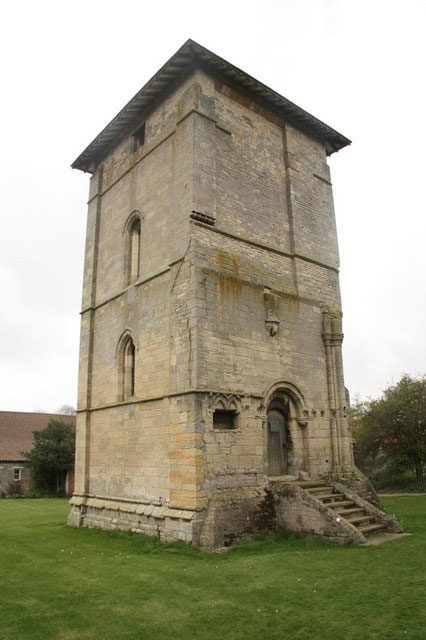
This tower is all that is left of the 1185 Bruer Preceptory of the Knights Templar ©Richard Croft, CC BY-SA 2.0

The small hamlet of Jerusalem, Linconshire ©Richard Croft, CC BY-SA 2.0
The Cross of Lorraine is also known as the ’double dagger’ or the ‘double cross’. (7) This may well reflect the murky double cross we see in Da Vinci’s ’Last Supper,’ where a disembodied hand wielding a dagger-like knife is close to Peter, who makes the menacing gesture of a slicing motion across the throat of the figure, who many now think to be Mary Magdalene. The dagger associations continue, for one of the key clues in my ‘Lincoln Cathedral Code’ is hidden at the misericords choir stalls within the Cathedral, the word ‘misericord’ deriving from the Latin word for ’mercy,’ meaning a dagger used in medieval times to deliver the death stroke (8). Another strange find is a wooden carving at the St Hugh Choir, for which there is no explanation. It is of a frog incising itself in the side with a dagger. Since a ‘dagger frog’ is a term to describe the leather that suspends from a belt or its scabbard, the carving is simply a surreal pictorial of a dagger.
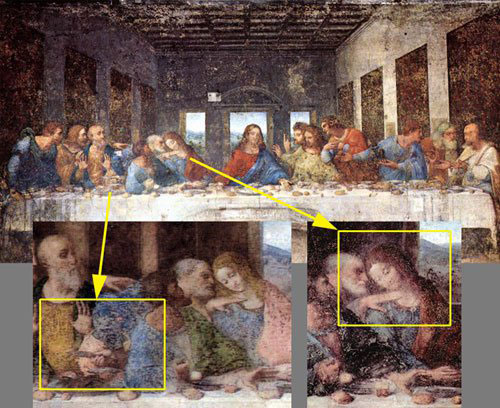
The Disembodied Dagger at the Last Supper. (Source: the Last Supper by Leonardo Da Vinci, 1495-1498).
Within the hotly debated, cryptic, clue-laden Rennes parchments back in France (according to some a keyword in its encryption), are the two French words ‘Mort Epee’. This translates as ‘Death sword’, (9,10) and a dagger is a small sword. At Temple Bruer, etched on a pillar and taken from the Runic alphabet, is the rune Dagaz, phonetic ‘Daggers’, a powerful symbol announcing ‘cataclysmic change’. (11) So what has all this to do with a comet?
Remaining in France, much of the hullabaloo circumvents around an alleged bloodline resulting from a child born of the biblical Jesus figure and the Magdalene. Much has been written about the strange Merovingian dynasty, of whom people would like us to believe are Jesus’ descendants, thus carrying this bloodline. Clovis, the first king of the Franks to unite all of the Frankish tribes under one ruler, is considered to have been the founder of this Merovingian dynasty. (12) Albeit a different one, the name Clovis, by way of synchronicity, puts in an appearance! The Merovingians bore the title of ‘The Long Haired Kings’.(13) From whence it follows, that the word ‘comet’, deriving from the Greek ‘Kometos,’ means ‘long haired’ in reference to its tail. The latin motto above the bizarrely masonic decorated church at Rennes-le-Chateau reads ‘Lumen in coelo’, which translates as ‘Light in the sky’. (14) A comet? Was there a secret society who somehow knew of what was to come, thus choosing to express themselves through the mysterious landscape of Rennes-le- Château?
There is more. Rene d’Anjou, an alleged master of the much touted and alleged secret society of the Priory of Sion 1418-1480, (as well as definitive King of Naples and Sicily) was no newcomer to the search for Mary Magdalene, excavating a crypt at the Notre-Dame de la Mer, looking for her remains. (15) In 1457 this renowned Grail hunter wrote a quest, The Heart Smitten with Love, of which part was a famous and cryptic illustration, ‘La Fountaine de Fortune’. A translation at a monument in the scene warns against ‘bitter water’.

La Fountaine de Fortune (Public Domain)
In ‘La Fountaine de Fortune’ we see, within the background, a hazy orb we presume to be the sun; but if we think instead of an approaching celestial body, we can interpret it as the fuzzy, temporary atmosphere of a comet, face on. That it is moving explains the anomaly in the picture of the cast shadows not being in the same direction where we would expect them to be if cast by a fixed sun. Bitter waters? If a comet hit any of our oceans the tsunami-producing result would certainly fit the various synonyms associated with the word bitter – hostile, fierce, calamitous, merciless, savage.
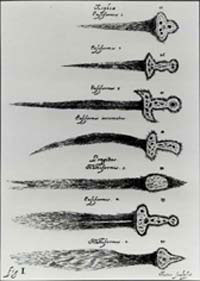
‘Cometary forms’ from Cometographia by Johannes Helevius (taken from Don Yeomans’ Comets: A chronological History of Observation, Science, Myth and Folklore).
Back to daggers. If we study the illustrations of cometary forms by 17th century polish astronomer Johannes Helevius, the founder of lunar topography who also located ten new constellations, we see how many clearly resemble a dagger.(16) David Wood suggests that a cometary impact would destroy most of the face of our planet, thus seeding in its aftermath, and in the body of its victim, a kind of cosmic fertilisation that can be seen not only as a life-threateningly horrific missile, but also as a vessel supplying the building blocks of life itself.
Finishing as we started with the theme of sexual imagery we can, if we wish, view things through both eyes and the expanded consciousness of theosophy, to see that sperm cells normally have long tails that help them swim towards the eggs awaiting fertilisation. Only one makes it to its awaited destination. Is this symbolic of the tail of a comet on its way to fertilise and seed new life on Earth?
If we cannot deflect what may have to be the inevitable, then we are involved in a greater cosmic mystery than we could ever have imagined.

German Renaissance master Albrecht Durer’s 1514 engraving ‘Melencolia 1’ is loaded with Freemasonry. Mathematical knowledge is referenced by the use of symbols, compass, geometrical solid, magic square and an hourglass showing time is running out.
The ideogram in the title is in two equal halves and two clockwise swirls both of ancient symbology. The top swirl has the meaning ‘outgoing migration or potential movement’, the counter clockwise swirl has the meaning of ‘rotation or returning, or homecoming to something’. Reference: ‘Discovering the Durer Cipher’, Elizabeth Maxwell Garner https://www.youtube.com/watch?v=qE4GPXPlhcc. Another source announcing the Clovis comet?
References:
- http://templarmechanics.com/map.asp
- http://news.bbc.co.uk/2/hi/uk_news/england/lincolnshire/5220930.stm
- Geneset, p265
- The Secret History of the World, p480
- Where Angels fear to tread, Stuart Wavell, Sunday Times 23/07/95
- https://www.pinterest.com/pin/478366791644423930/
- https://www.tititudorancea.net/z/cross_of_lorraine.htm
- www.dictionary.com/browse/misericord
- http://dictionary.reverso.net/french-english/mort
- http://dictionary.reverso.net/french-english/epee
- www.llewellyn.com/encylopedia/term/dagaz
- https://www.britannica.com/biography/Clovis-l
- The Merovingian Kingdoms 450-751, p. 537.
- http://mymemory.translated.net/en/Latin/English/lumen-in-coelo
- The Templar Revelation, p.89
- Johannes Hevelius, Cometographia, 1668.
Bibliography
Cometographia, Johannes Hevelius, 1668;
Comets: A chronological History of Observation, Science, Myth and Folklore; Don Yeomans, Wiley, 1991;
The Holy Blood and the Holy Grail, Baigent, Lincoln & Leigh, Jonathan Cape, 1982;
GenIsis – The First Book of Revelation, David Wood, The Baton Press, 1985;
Geneset – Target Earth, David Wood & Ian Campbell, Bellevue Books, 1994;
Magicians of the Gods, Graham Hancock, Coronet, 2015;
The Merovingian Kingdoms 450-751, Ian Wood, Routledge, 1994;
The Secret History of the World, Jonathan Black, Quercus New edition, 2010;
The Templar Revelation, Picknett & Prince, Corgi Books, 1998.








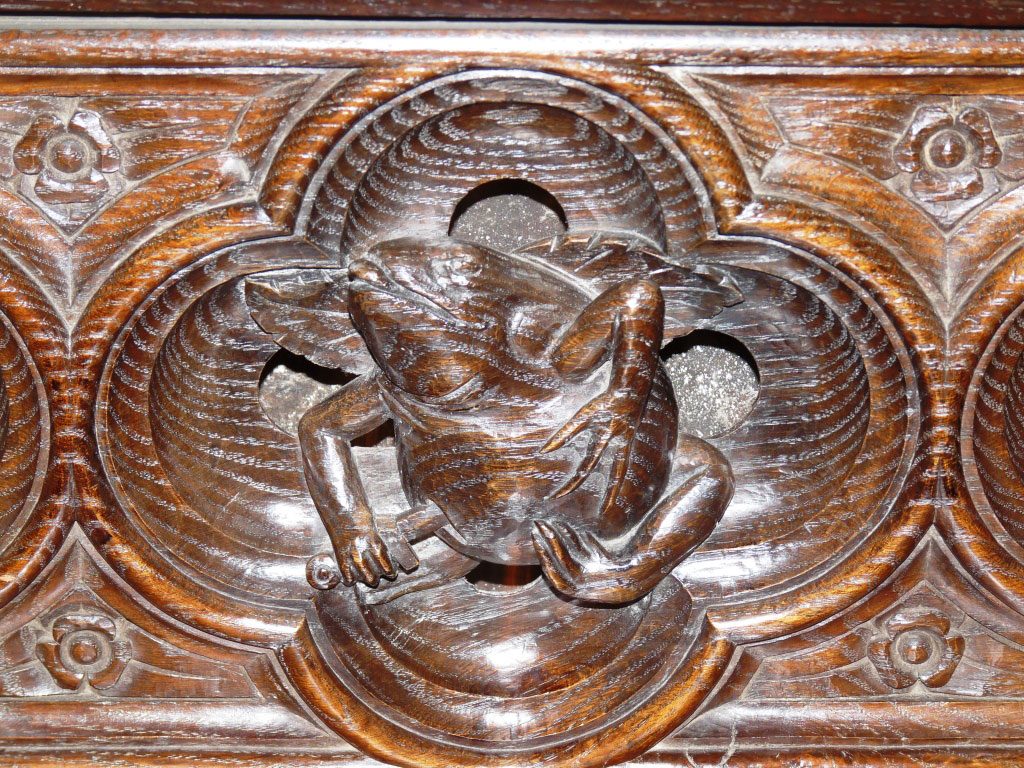
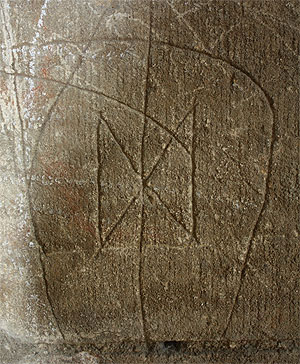
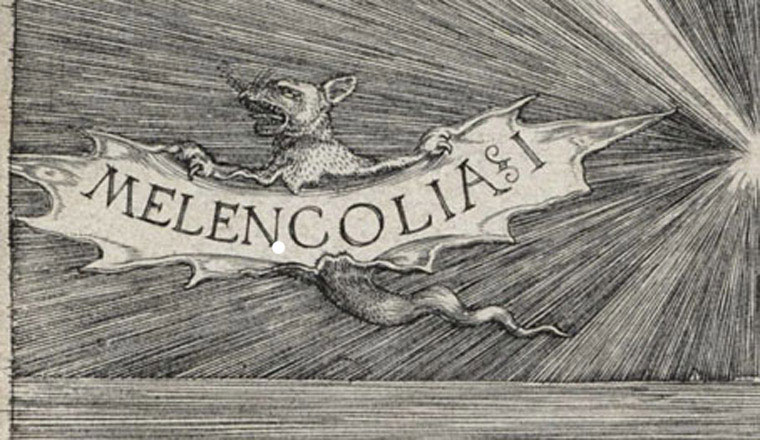
Jean Cocteau writes on the topic of a comet as well in an essay he wrote about his chapel in the South of France. I do not recall the essay title but he was quite explicit that a catastrophe occurred on the opposite side of the world from Europe. Cocteau is well known in those French circles of Masonry and is alleged to have been a master of the Priory of Sion.